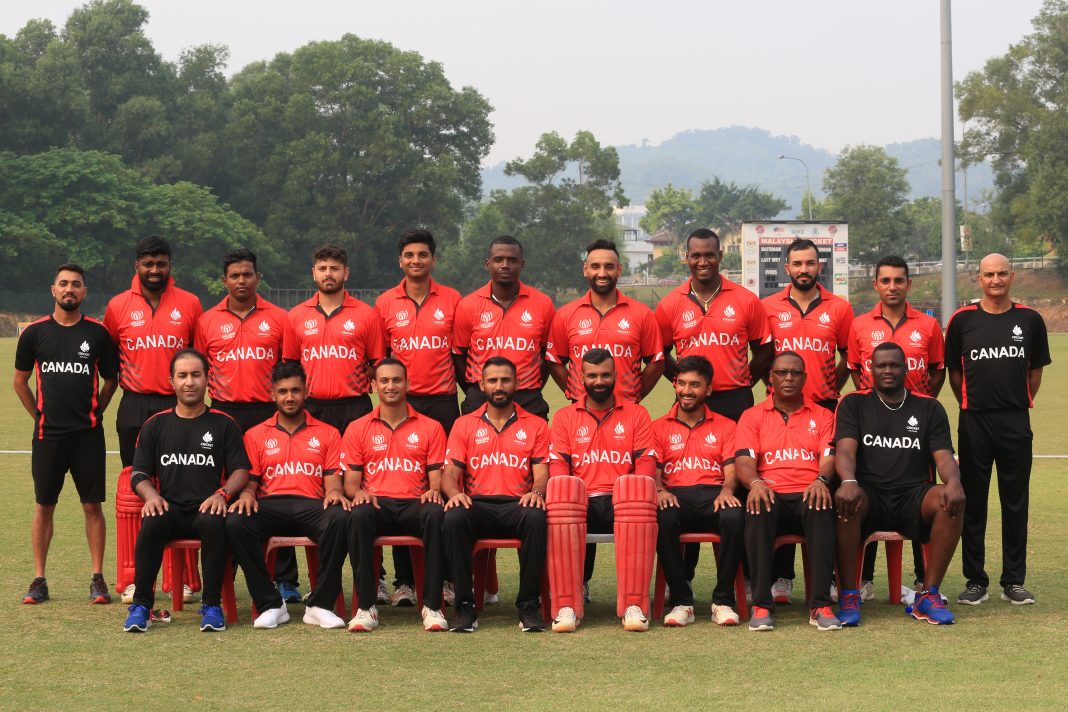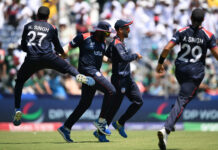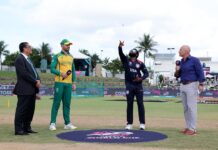Background
It’s been a long time between drinks for Canada. Their last appearance at a global event was the 2011 World Cup – a distant, hazy time when John Davison still opened the batting, Henry Osinde took the new ball and Pubudu Dassanayake was coach. After Pubudu’s departure, Canada has rarely challenged for a place on the world stage, with a series of ignominious exits in the group stages of 20 and 50-over World Cup qualifiers capped by a heartbreaking loss to Nepal in 2018’s WCL2. This ended their unbroken run of appearances in the World Cup qualifying event dating back to the inaugural edition in 1979 (when it was known as the ICC trophy). Seeking redemption in Namibia earlier this year, Canada was again denied a place at the top table of Associate cricket. Facing off against their former mentor Pubudu, then overseeing neighbours and rivals the USA, they fell agonisingly short of the NRR target required to overhaul PNG’s remarkable recovery, and were duly relegated to the Challenge League.
Since then, though, Canada has undergone a mini-revival, with a remarkable turnaround in form seeing them exact some small measure of revenge on the USA as they went comfortably undefeated in the Americas regional final to seal a place at the global qualifiers and block the old enemy along the way. They followed up with a dominant showing in the first Challenge League outing, racking up a trio of 300+ scores – including a List A record of 28 sixes on the way to 408/7 in their demolition of Malaysia. A final day thriller saw the Canadians fall in the last over of a rain-shortened chase against Singapore but with a number of batsmen finding rope-clearing form, they come into the global qualifiers riding high.
The team sheet
There were few surprises in the squad announcement, with minimal changes from the core Challenge League and Americas Final group. Explosive T20 veteran Rizwan Cheema comes back in and seamer Cecil Pervez is shuffled out after an anonymous time in Malaysia, while Junaid Siddiqui bolsters the spin contingent with his leg breaks and young left-hander Nicholas Kirton provides batting cover.
With over a decade of experience for Canada, the 41-year-old Cheema is likely nearing the end of his time in red. He remains as fit as any in the squad, though, and his six-hitting ability is undiminished, as he showed in Bermuda when he flattened the hosts with 72 (35) in a lopsided chase of 120 in just 13.1 overs. As always consistency will be an issue, but in the twilight of his career Cheema has finally settled into his niche as an all-out attack T20 opener who can wrest the momentum in an instant but, crucially, doesn’t waste many deliveries when he fails. A serial underperformer at ICC events, Cheema will be looking to make up for lost time and blast his nation onto the global stage one last time.
Since assuming the captaincy in the wake of Davy Jacobs’ decision to focus on his construction business (amidst rumblings of discontent over player salaries ahead of the GT20), Navneet Dhaliwal has been a revelation. He topped the Canadian run tallies in both Bermuda and Malaysia with 190 and 250 respectively – the latter despite playing only 3 of the 5 matches after coming down with a fever. His 140 off 94 balls as he put Malaysia to the sword was as clinical a display of batsmanship as any willow-wielder could hope for, striking it cleanly all round Kinrara Oval, but especially brutal straight. A well-oiled technical solidity makes Dhaliwal perfect to slot in at 3 and provide cover for the boom-or-bust opening pair of Cheema and Rodrigo Thomas, as demonstrated by a responsible 72* to anchor Canada’s slightly wobbling chase in their opening encounter with Vanuatu, whilst his newfound ability to move rapidly through the gears will mean he can modulate the run rate according to match situation.

With the ball, Canada will again be led by the experienced right-arm/left-arm finger spin team of Nikhil Dutta and Saad bin Zafar. With left-arm orthodox emerging as something of a cheat code at both franchise and international level, Canada will look to the classy Zafar for his ability to tie down the scoring rate – he was the most miserly of their bowlers in Malaysia, going at just 3.5 per over, whilst remaining a wicket-taking threat with his variations in flight and speed.
Nikhil Dutta is another, also with T20 franchise experience, who will be crucial to restricting opponents to chaseable scores in the UAE. Working in tandem with Zafar he forms one of the more restrictive bowling partnerships in Associate cricket as they’ll seek to hustle through 8 probing overs as quickly as possible. Middle-order bat Nitish Kumar has also steadily improved his bowling over the past 18 months and provides another handy offspin option, whilst drafting in the legspin of Junaid Siddiqui will offer some more variety in the desert conditions expected to favour spin.
Seeking to impose a repressive regime on the batsmen, seamer GDR Eranga is another who will be crucial to Canada’s defensive bowling plans, with canny variations in his awkward left-arm angle, as well as an ability to extract swing through the air with the new ball. A bagful of guile and disciplined lines means Eranga is ideally suited to out-thinking batsmen looking to go hard in the power play.
Possibly joining him with the new ball is Canada’s most aggressive bowling option in Dilon Heyliger, a muscular quick with proven ability to bend his back and extract nasty bounce from a deck offering any assistance. Despite his wicket-taking capacity, though, Heyliger is prone to fits of waywardness if he loses rythym in his slightly awkward action. After an indifferent time in Malaysia, Canada will need to weigh the risks of playing a man who doesn’t always get it right against less incisive but more consistently disciplined bowling options in their squad – especially if pitches are not conducive to the fast men. Replacing him with Siddiqui and playing 3 specialist spinners is also a possibility, with skipper Navneet Dhaliwal capable of sending down some tidy medium pace.
One to watch
Special mention must go to Ravi Singh. To outpace Rizwan Cheema is an achievement in itself, but to overshadow him completely, as he did in the regional finals in Bermuda, is something else entirely. Bursting onto the scene as the first man to make a century on T20I debut (against the Cayman Islands), he also feasted on a wayward USA bowling unit as he took his tournament tally to within 1 of leader Navneet Dhaliwal, all at the mind-boggling strike rate of 191. He further enhanced his credentials in Kuala Lumpur with a blistering 94 (46) in the rout of Malaysia, and a series of late-innings cameos collected 214 runs at a tournament-high strike rate of 163. Since making his T20I debut in August, Singh has faced 230 balls in both 20 and 50-over cricket, and clobbered 33 sixes – an astonishing 14.3% of all deliveries clearing the ropes. It’s this ability to hit from the first ball which will be crucial to Canada’s middle order acceleration.

Tournament prospects
A big-hitting top order finding form, the ability to stabilise or accumulate if required, and Ravi Singh playing a middle-order floater role to provide explosive acceleration later in the innings means that Canada’s batting for the first time in many years looks genuinely dangerous. Add keeper Hamza Tariq and Saad bin Zafar’s combined slogging ability and Canada are a side capable of reaching some massive scores. The bowling approach appears to be coalescing around a flotilla of defensive options, whose collective discipline may well frustrate some of the more free-flowing batting units in the competition; this potent one-two punch of expansive hitting and restrictive bowling should in this author’s opinion be enough to see Canada through to their first ICC event in almost a decade.
Best XI (predicted): Rizwan Cheema, Rodrigo Thomas, Navneet Dhaliwal (c), Nitish Kumar, Srimantha Wijeyeratne, Ravi Singh, Hamza Tariq (wk), Saad bin Zafar, Dilon Heyliger/Junaid Siddiqui, Nikhil Dutta, Romesh Eranga.







